Living in a place with the highest number of historically active volcanoes in the world (as per USGS), most Indonesians (except for those living in Borneo and a few other islands) have for generations been accustomed to living a life attuned to the deadly cycles of those fiery mountains. When they erupt, volcanoes take lives – those of humans, animals, and plants – but the trails of destruction they leave always become perfect ground for rebirth. Soils are replenished with minerals, pioneering plants start to grow, and in a few years’ time other forms of life return. Although there are a number of volcanoes where you can see the evidence of this cycle, Mount Papandayan in Garut provides a particularly good and relatively accessible example for those who wish to see how a volcano takes and gives life.
With me at the steering wheel and James as the navigator, one Friday morning we left the comfort of our hotel for this volcano, which can get very popular on weekends. Google Maps recommended what appeared to be a pretty straightforward route to Papandayan. But in reality, it took us through towns with extremely busy markets that spilled over into the already narrow street. We had to move at a snail’s pace, but there was no other option than to keep going forward. As it also happened to be a cloudy morning, I was hoping by the time we arrived at our destination the weather would have improved.
It wasn’t until we came across a bigger road that driving became a lot easier. Motoring along at a steady speed, I kept following a few cars in front of me until we reached a point where a small village street forked out of the main artery. All I had to do was follow it and soon I realized I’d made the right decision to get my car checked before going to Garut – the mechanic had found an issue with the braking system which required a component to be replaced. Had I not done that, I would have not had the courage and confidence to keep going on this narrow road with an incline that felt increasingly steep as I drove closer to the volcano. In the last few kilometers, I even had to step on the gas pedal deeper and make the car engine work harder. It was quite tense to be honest, but as soon as we arrived at the surprisingly wide parking area and opened the car doors, we were welcomed by cold yet refreshing mountain air. We went from a little less than 800 meters to more than 2,000 meters above sea level in about one and a half hours.
After a much-needed toilet break and a touch of cold alpine water, we began our hike toward the crater. The top of the hill right in front of us was still covered in thick fog, but I remained hopeful that the weather would eventually improve. Papandayan is a stratovolcano that has erupted several times in the past few centuries. An eruption in the 18th century caused its northeastern side to collapse which resulted in a catastrophic debris avalanche that destroyed dozens of villages and killed thousands. Coincidentally, a few weeks before going to Garut I watched a documentary from National Geographic about Mount St. Helens’ massive eruption in 1980 which obliterated its northern face. Whether the circumstances around both eruptions were similar or not, I don’t know for sure. But because of the way Papandayan looks now – with its open crater visible from afar due to the collapse of one side of the volcano – I couldn’t help but think of that harrowing minute-by-minute animated reenactment of Mount St. Helens’ eruption that is made possible by current technology.
Less than ten minutes from the start of the hike, I could already see smoking fumaroles coming out of the crater. As expected, the closer we approached, the stronger I could smell sulfurous gases in the air. The white fumes rose from cracks in the ground, before merging themselves with the low clouds that were hanging above us. It was a landscape tinted in greyscale; even the green colors of the shrubs around us were muted. We took a short break near the crater to take some photos before continuing to the first of three stops on this hike.
Hutan Mati, literally ‘dead forest’, is undoubtedly Papandayan’s most iconic site. Located above the crater, it can be reached via a set of stairs specifically made to give visitors easier access to this much-photographed location. It only took us about ten minutes from the bottom of the steps to the end, but for me it felt much longer – maybe due to the elevation – as I made sure not to go up too fast especially after that frightening experience on the Cisadon Trail a month earlier. At Hutan Mati, there were only two other visitors, and because of the grim and quiet setting with hundreds of dead tree trunks dotting the landscape, suddenly the eerie soundtrack from a scene in The Lord of the Rings: The Two Towers where Gollum leads Frodo and Sam through the Dead Marshes played in my head. These dead trees are silent witnesses to Papandayan’s eruption in 2002, but almost two decades later visitors can now see how plants have started to reclaim this barren land which was once filled with vegetation.
Moments after we arrived at Hutan Mati, the clouds began to open up, allowing the sunlight to reach this highland. Then, like magic, this very landscape that felt sinister a few minutes earlier was suddenly filled with a burst of colors: green, yellow, and dark red from trees and shrubs that grow in this part of Papandayan. After taking more than enough photos at our first stop, we moved on to the second location called Pondok Saladah… only if we could find the way to go there. From Hutan Mati, it took us a while to spot the trail to our next destination as it wasn’t signposted. However, once we found it, the path became clearer and clearer, and reaching Pondok Saladah was quite straightforward. Along the way, something beautiful stole my attention. It was a plant that looked familiar yet foreign. It turned out to be the Javanese edelweiss (Anaphalis javanica), a flowering plant found mostly in some of Indonesia’s mountainous regions. Later when I had returned to Jakarta, I looked up the photos I took from Mount Rinjani in 2013, and my memories served me right. I did take a photo of the same, albeit much smaller, plant when I was waiting for sunrise at Indonesia’s second tallest volcano all by myself.
From afar, a Javanese edelweiss tree at Papandayan will likely catch your attention, for its silvery needle-like foliage with dainty yellow and white flowers are quite a contrast to its primarily green surroundings. When you put your nose close to the blooms, you’ll notice a pleasant sweet scent emanating from them. First identified in 1819 by a Dutch botanist Caspar Georg Carl Reinwardt who discovered it on the slopes of Mount Gede – one of West Java’s most prominent mountains – Javanese edelweiss is famous for its ‘eternal’ flowers that can last up to ten years. This pioneering plant is often found around a volcano’s crater where most other flora can’t grow. Unfortunately, this beautiful and unique species is currently critically endangered, which explains the relatively harsh penalty for anyone picking its flowers or causing any harm to the plant.
At Pondok Saladah, we saw an even greater number of Javanese edelweiss, and they were much bigger than the specimen we saw earlier, so much so that each individual plant seemed to outgrow one another. We walked along what I like to call the avenue of Javanese edelweisses and were the only visitors at this unlikely wonderland. Due to the abundance of fresh water and its wide open space, Pondok Saladah has become a popular camping ground. However, since we were not going to spend the night on the mountain, we had to keep moving to the third location called Ghober Hoet. As we walked along the dirt path that cuts through a dense forest, James suddenly stopped when he saw a viewpoint from which we could see the puffs from the fumaroles, the dead trees of Hutan Mati, a small waterfall, and lush green peaks all in the same frame. Thanks to his sharp eyes we got to take some shots from this seemingly less popular angle.
When we arrived at Ghober Hoet, we did see some more Javanese edelweisses, but they were nowhere as big as the ones we saw in Pondok Saladah. So, we didn’t spend too much time in the third stop and kept moving toward the point where we started the hike a few hours earlier. By this time, the clouds had mostly cleared up, leaving the hot scorching sun shining right above our heads for the rest of the hike. Prior to this trip, I read about how a lot of people consider this trail friendly for beginners. I won’t necessarily see myself as a beginner since I’ve done more challenging hikes in the past, but I wouldn’t say this hike was easy either. One must be reasonably fit to do this as there were some parts of the trail that required strong legs and a good technique. However, we did do this in the opposite direction as to how most people would – starting at Ghober Hoet and ending at Hutan Mati – and maybe doing it the other way would have been easier.
Four hours after the start of the hike, we finally reached the parking area again – we spent a considerable amount of time taking photos with me ending up having more than 1,000 images from this mountain alone. At first our plan was to drive back to town and find a place to have lunch there. But we were already starving, so we decided to just go to one of the food stalls around the parking area. I usually avoid having meals at a touristy place since the prices are often inflated for something that tastes just okay. With that in mind, I didn’t expect much from these stalls other than something that is filling. We stopped by the first stall we saw and perused the menu, which was printed on a banner hanging from its roof. I asked the lady who seemed to be the owner about nasi komplit, literally ‘complete rice’, and she explained to us that it came with fried chicken, tempeh, and tofu. James nodded in agreement and I ordered the same dish for both of us.
After about 10 minutes or so, she came out from her small kitchen at the back of the stall with our lunch. Surprisingly, everything looked very nice, and we immediately dug in after she brought us a small bowl of sambal for that extra kick. (If you’ve watched Raya and the Last Dragon you probably noticed that this separate container of chili sauce/sambal is essential in the Southeast Asian street food scene.) Oh my! Wow! I was caught off-guard and genuinely impressed with the quality of the food. Every single thing on the plate tasted ‘right’ and delicious; the chicken was well-seasoned with a Sundanese spice mix, the kemangi (Indonesian basil) so fresh, the green eggplant and sliced cucumber crunchy, the rice moist, and the sambal addictive. Of everything I ate in Garut, this surprised me the most, not because the dish itself is unique – on the contrary, it’s quite a common set meal – but rather because of how good it was. With a happy tummy, I went inside the stall to talk to the owner and pay. But this time I decided to use Sundanese (as opposed to Indonesian which I used earlier). I told her how delicious everything was – we even finished the whole container of sambal – and she was delightfully surprised by the fact that I spoke to her in her mother tongue.
A perfect meal to wrap up a nice hike. I couldn’t ask for anything better. Feeling tired yet happy and well-nourished, off we returned to the city with big smiles on our faces.
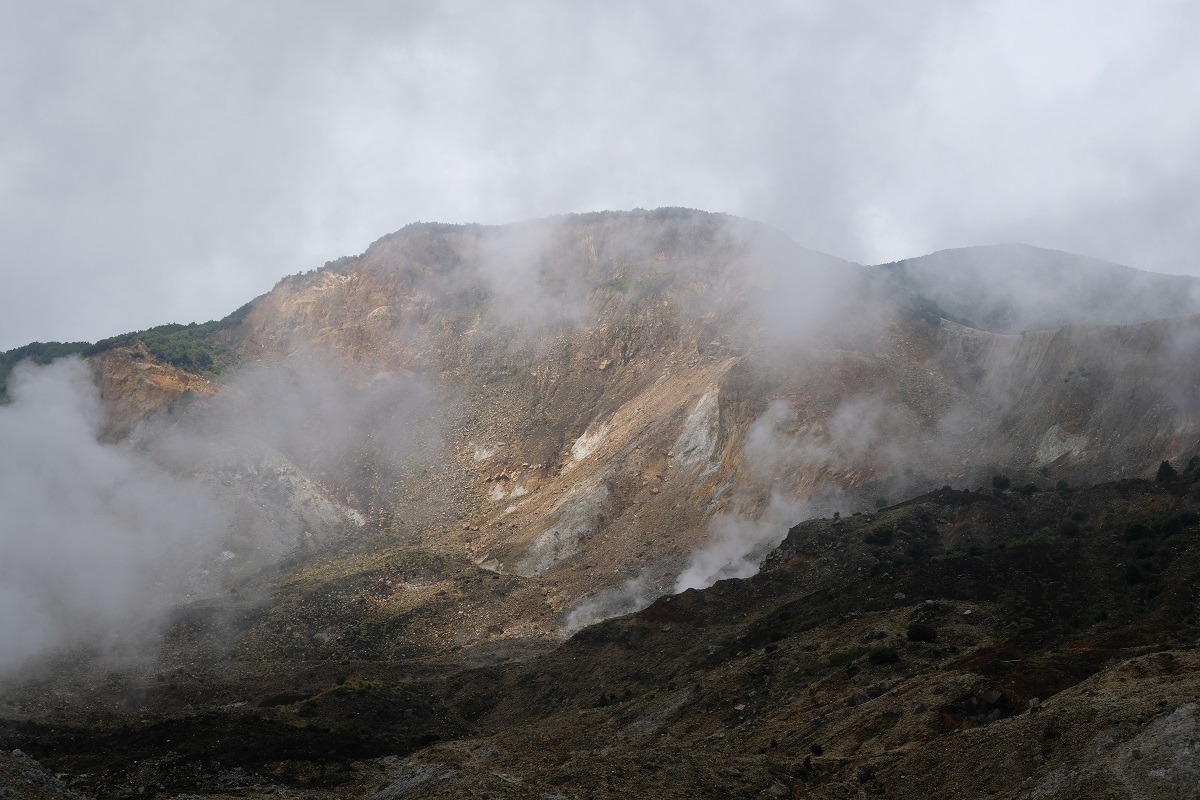
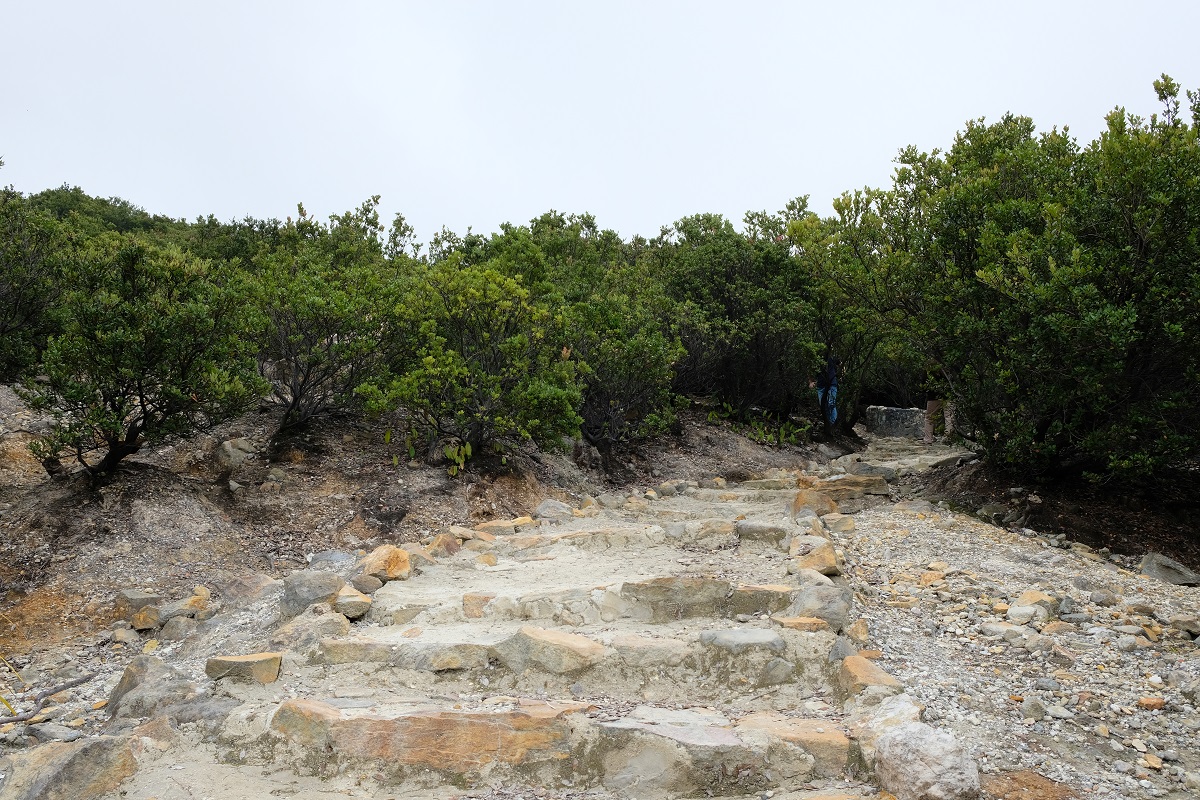
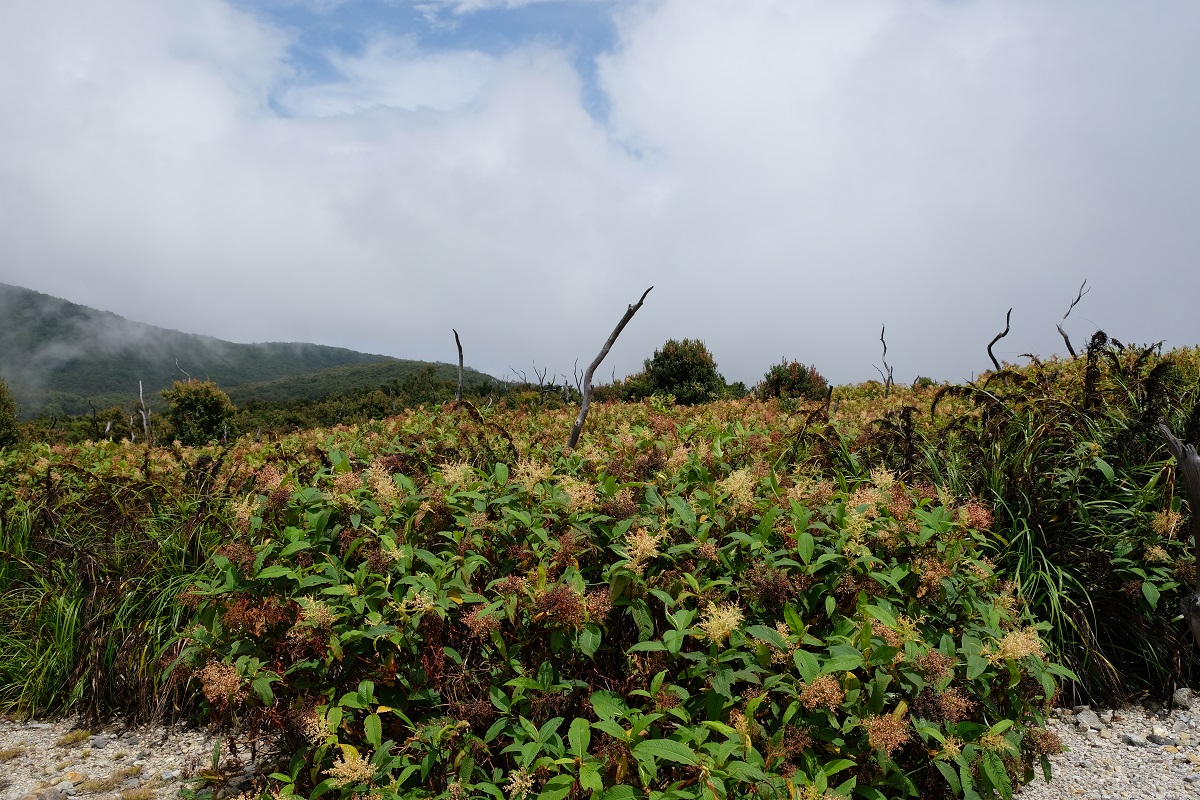
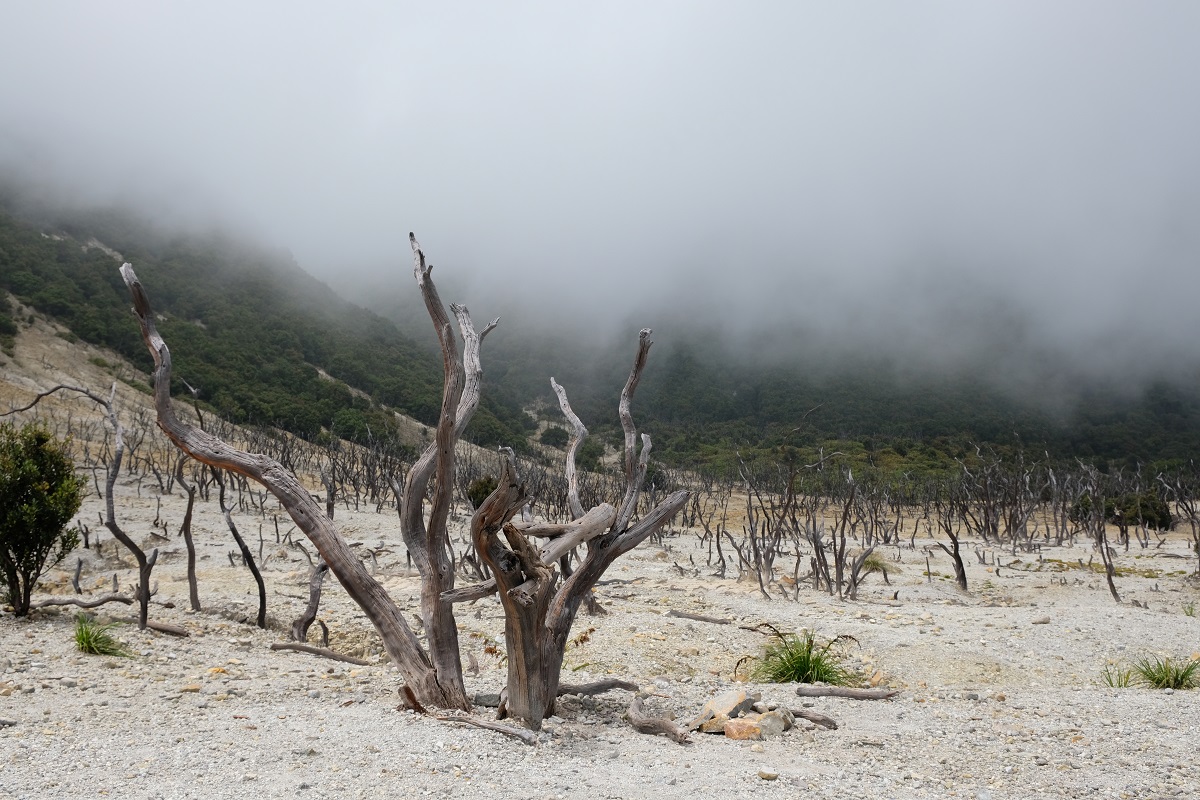


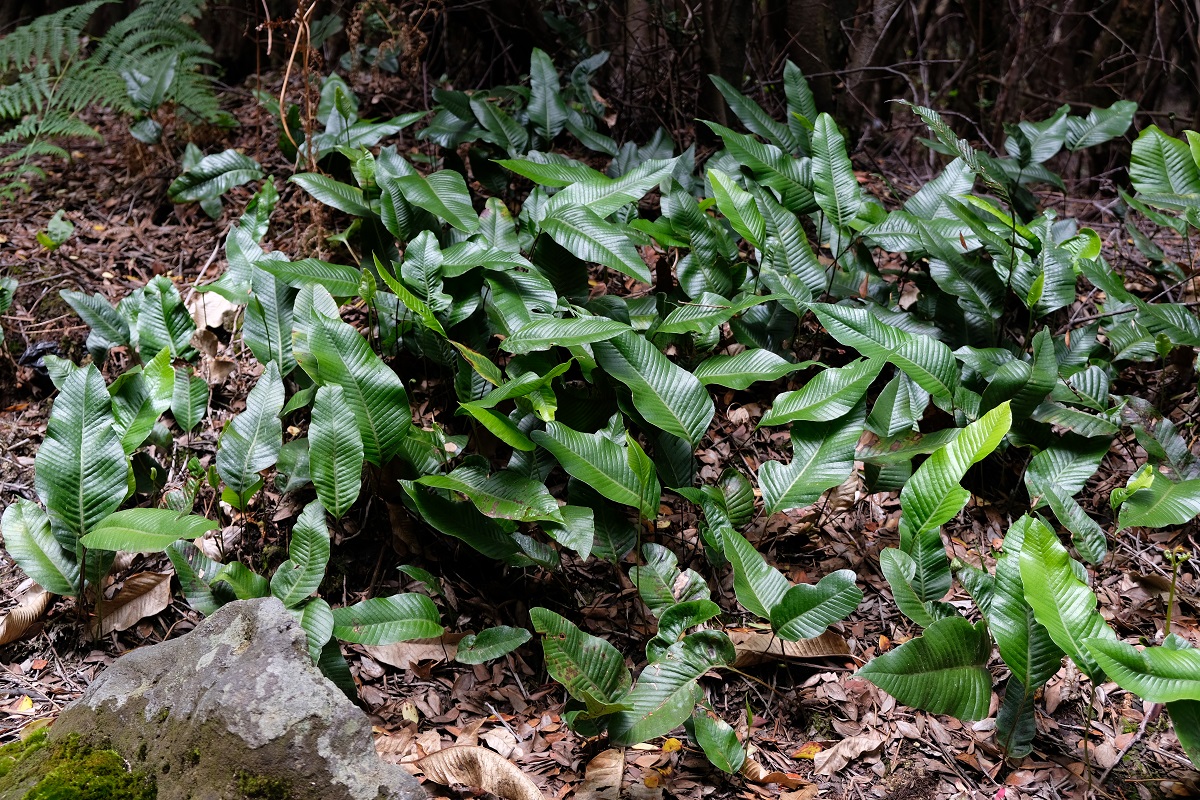



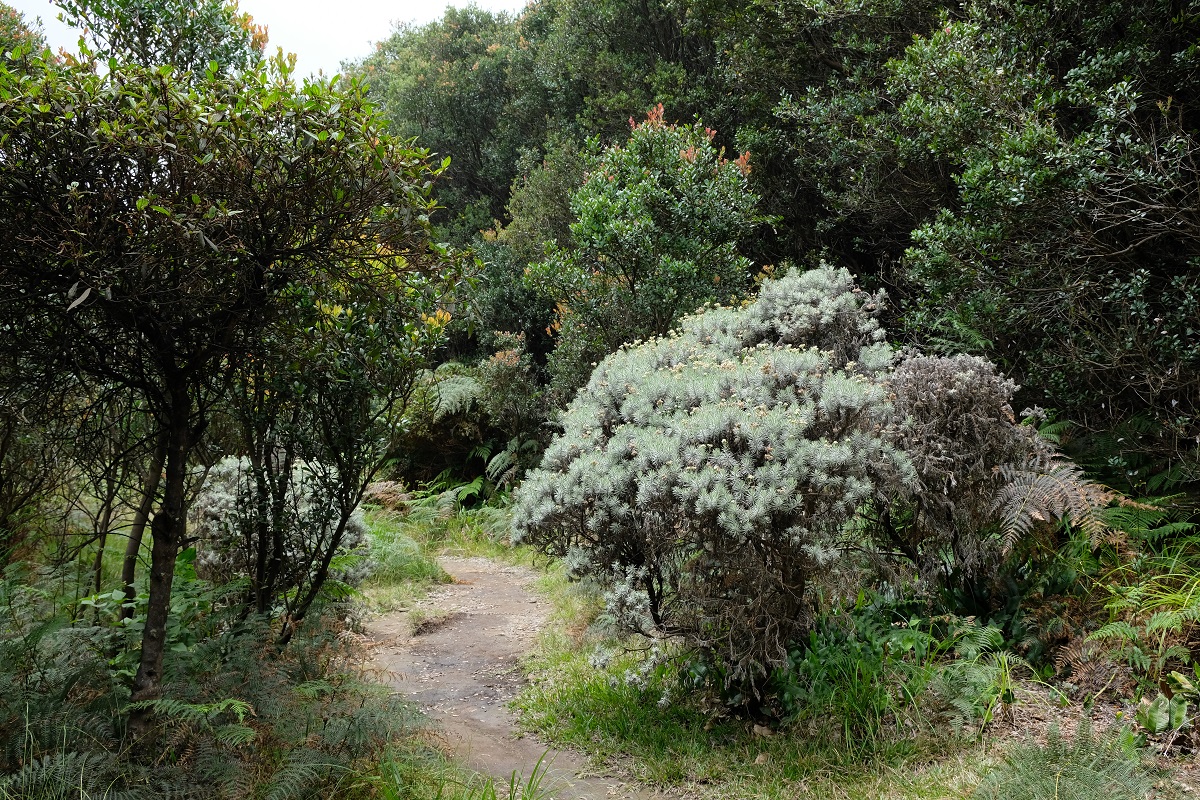
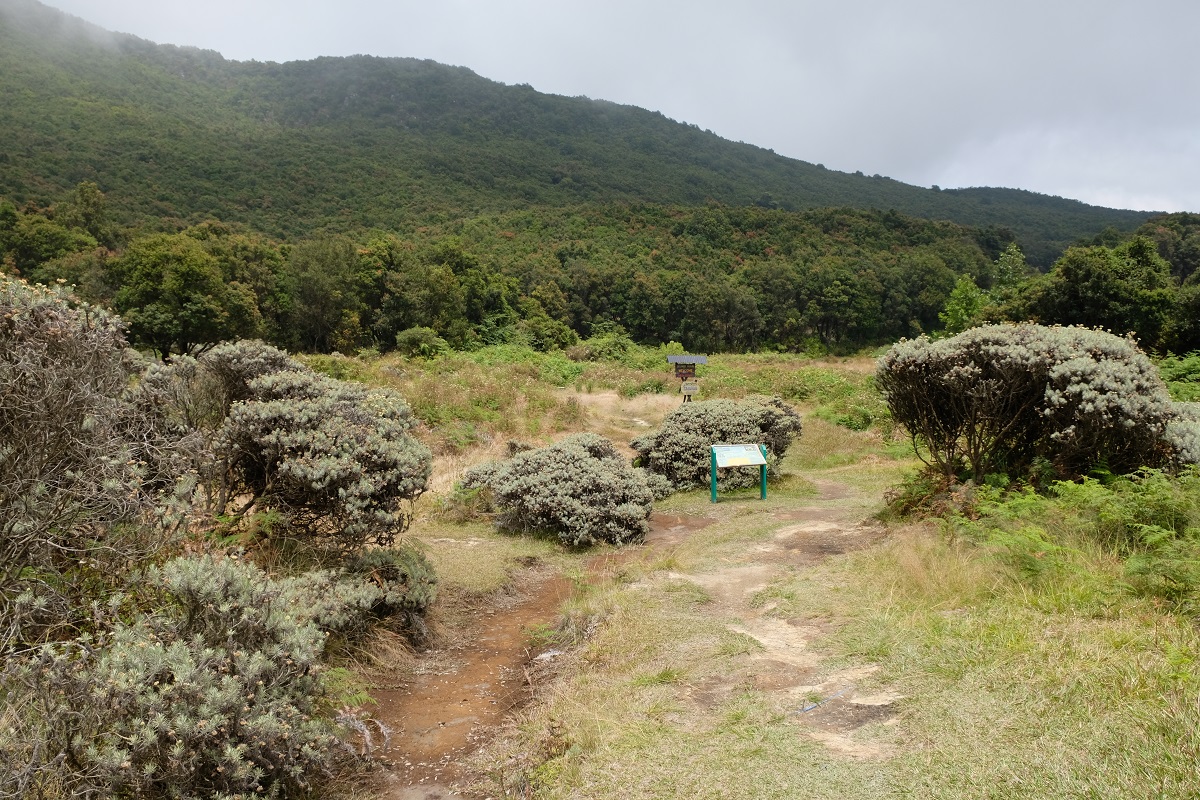
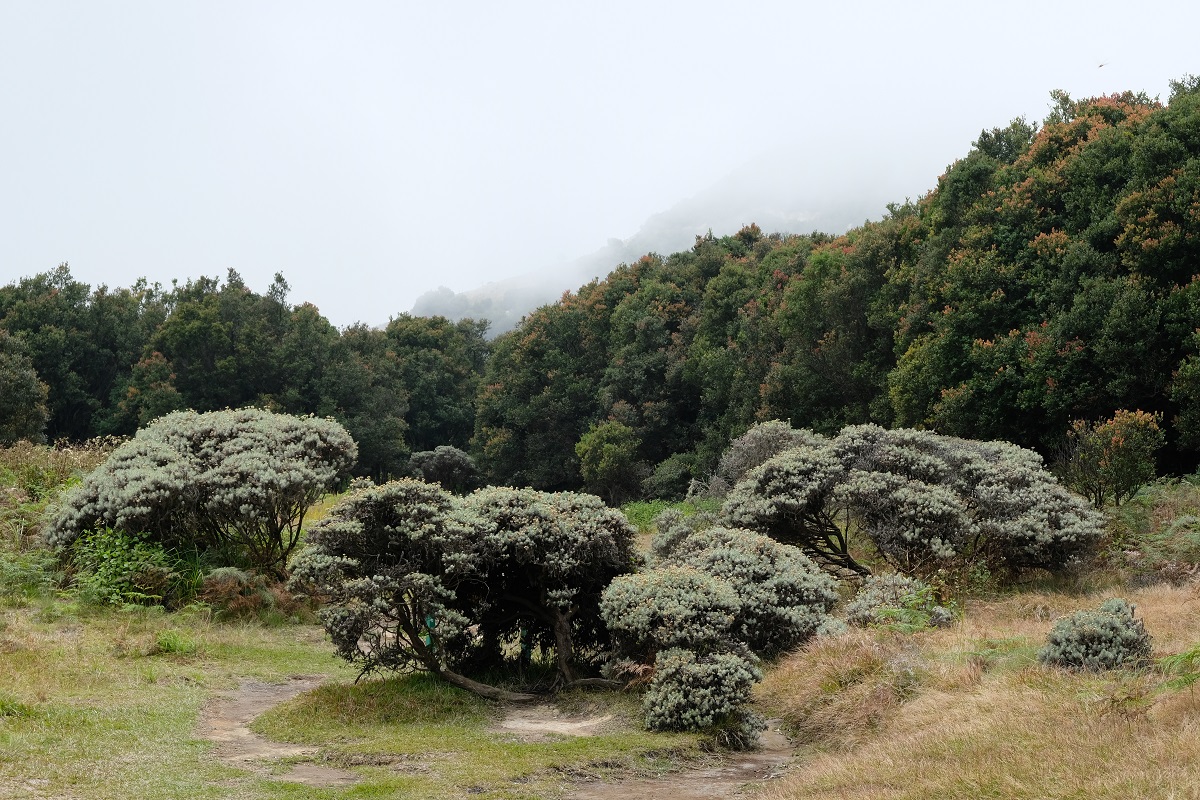
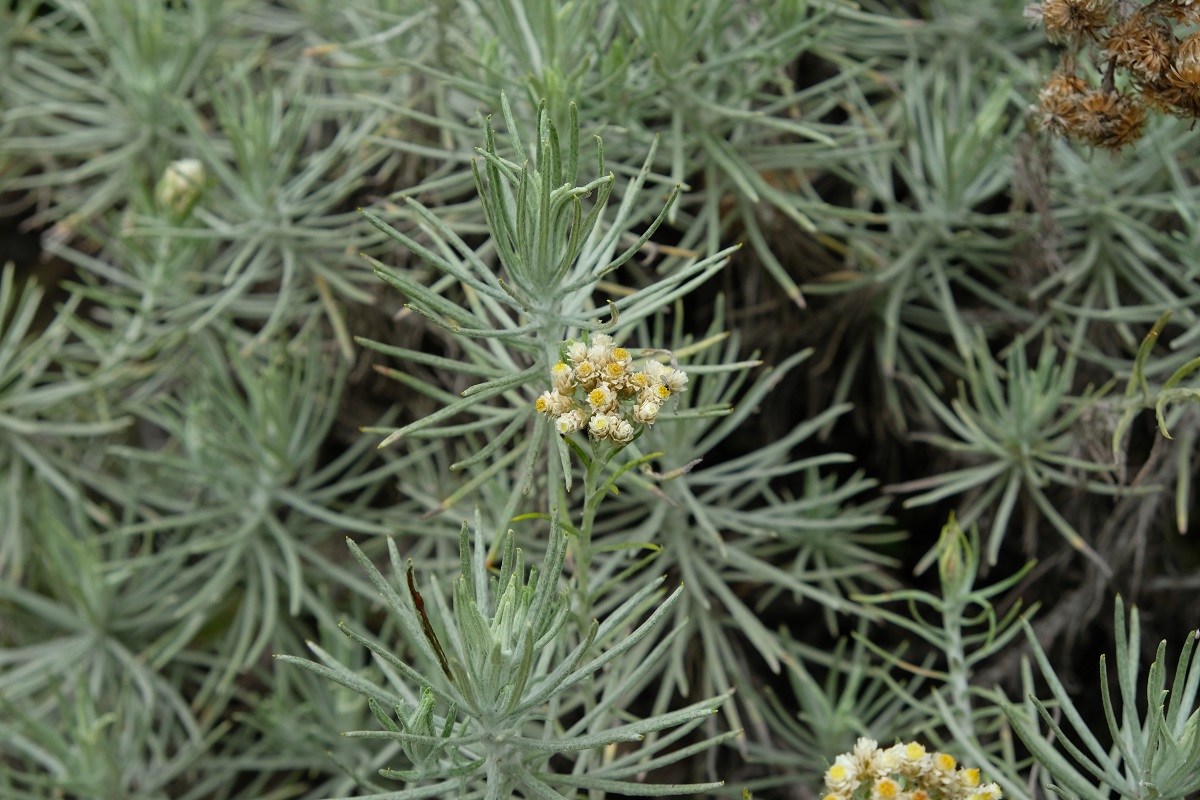
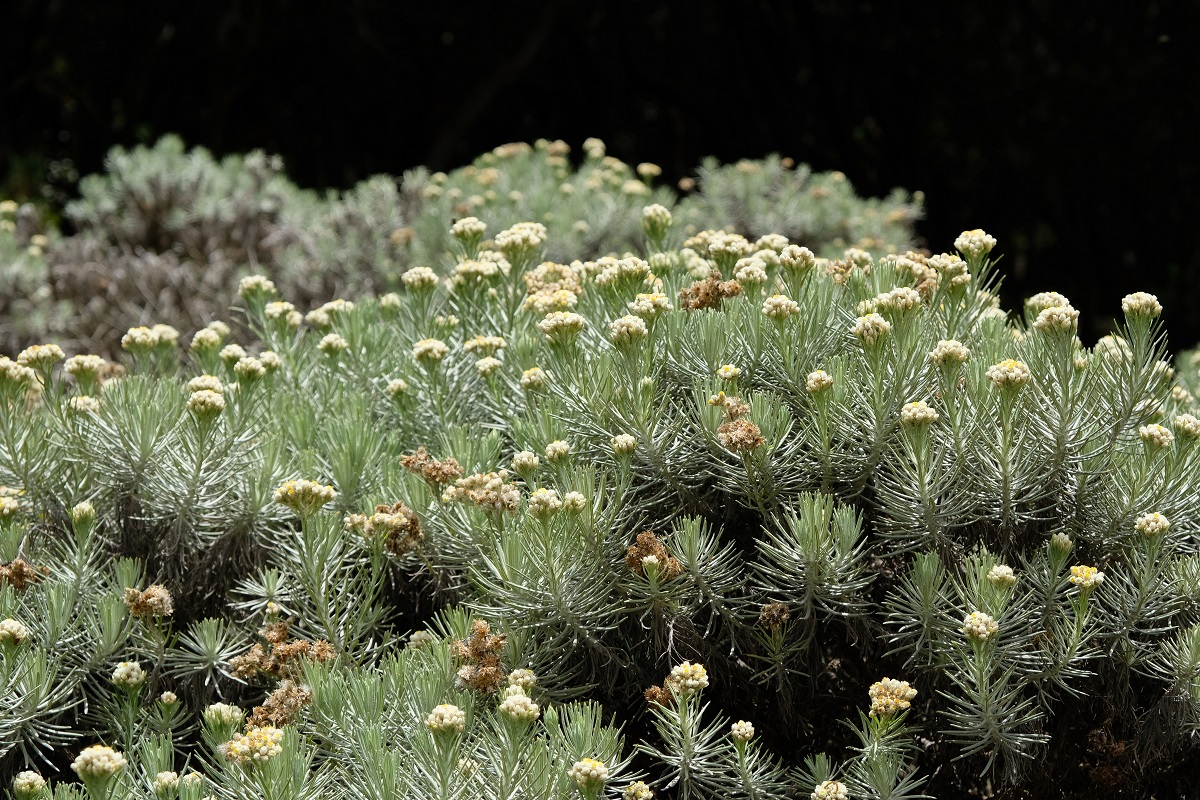


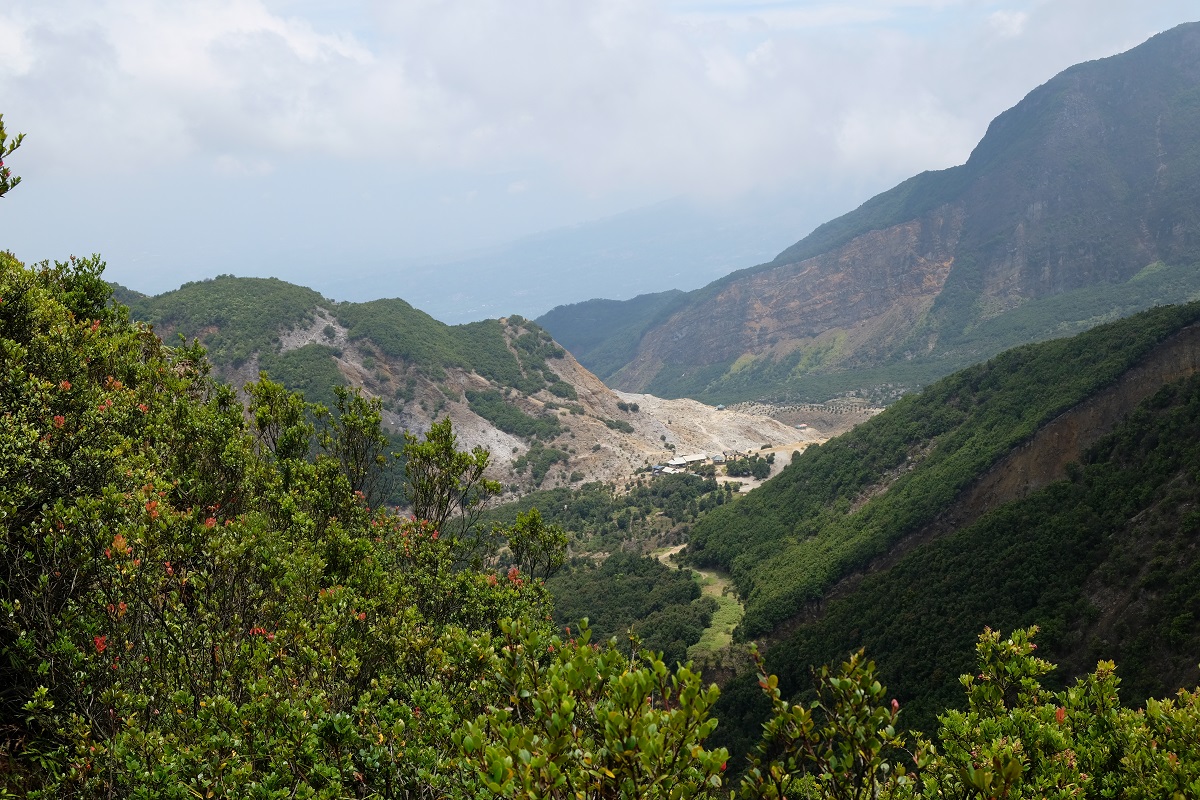
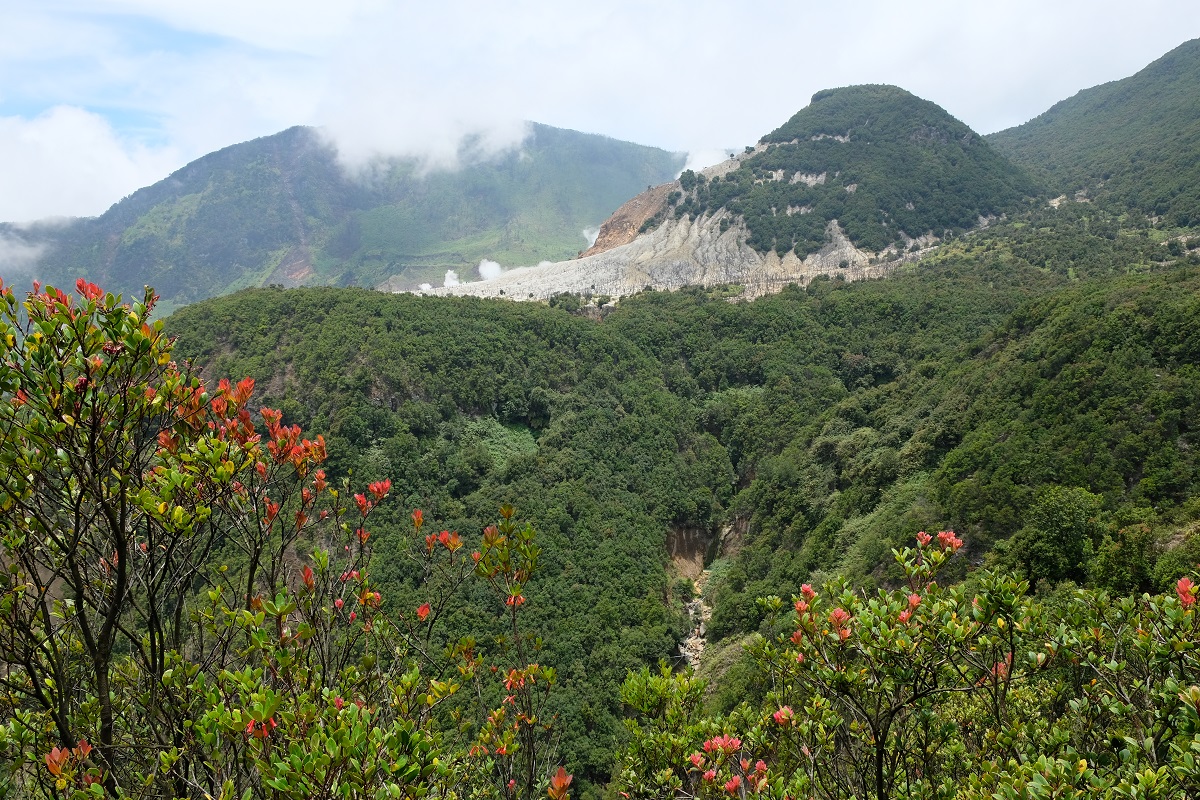
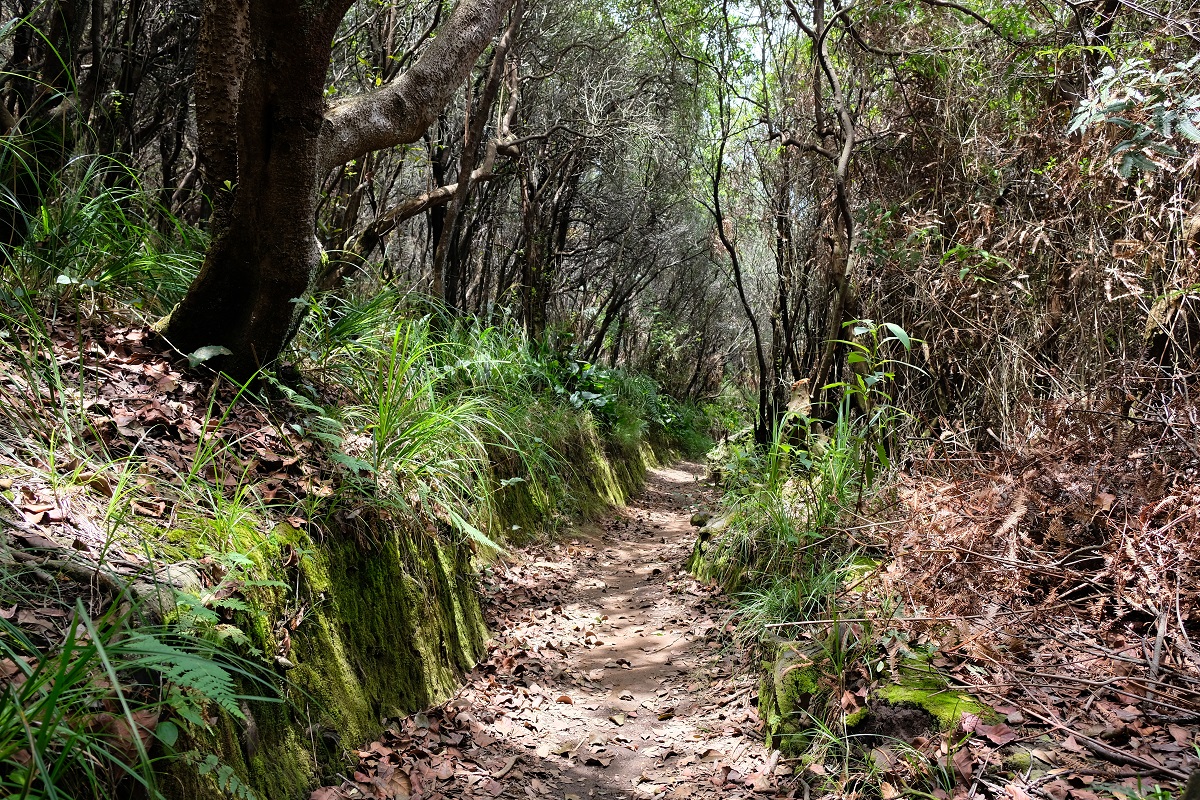

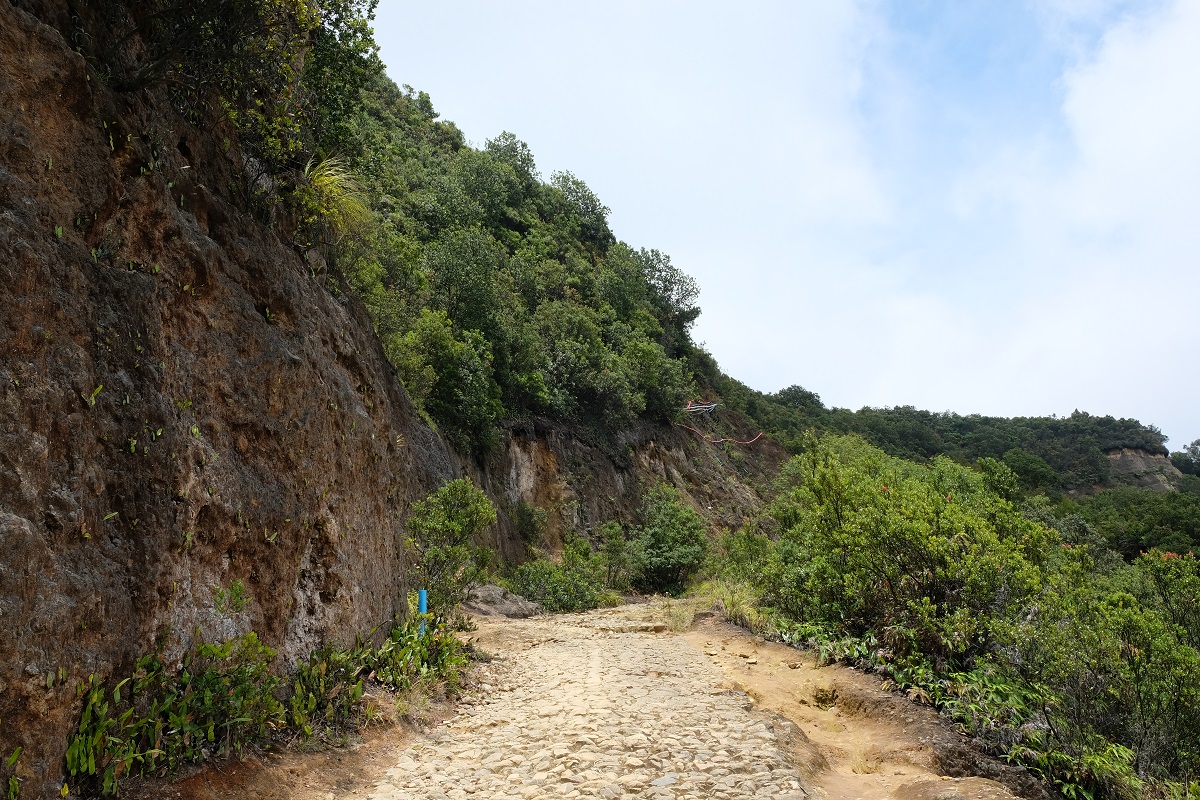
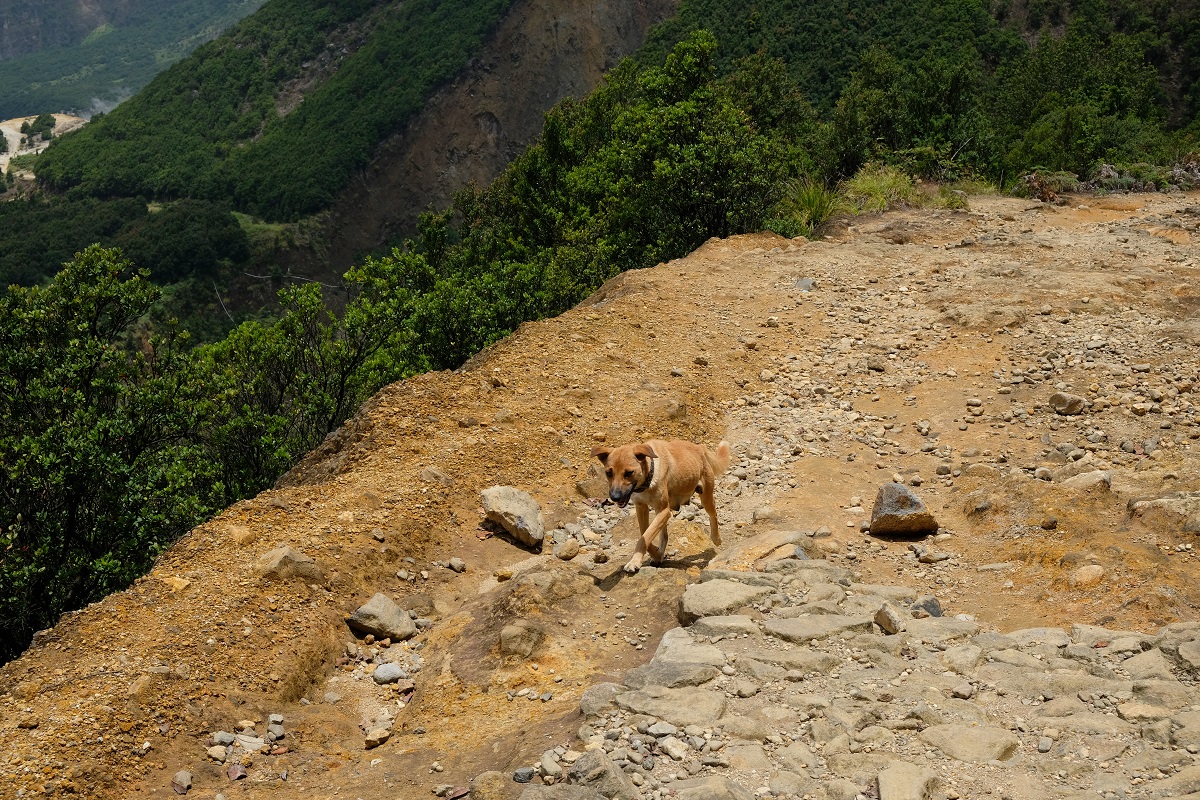


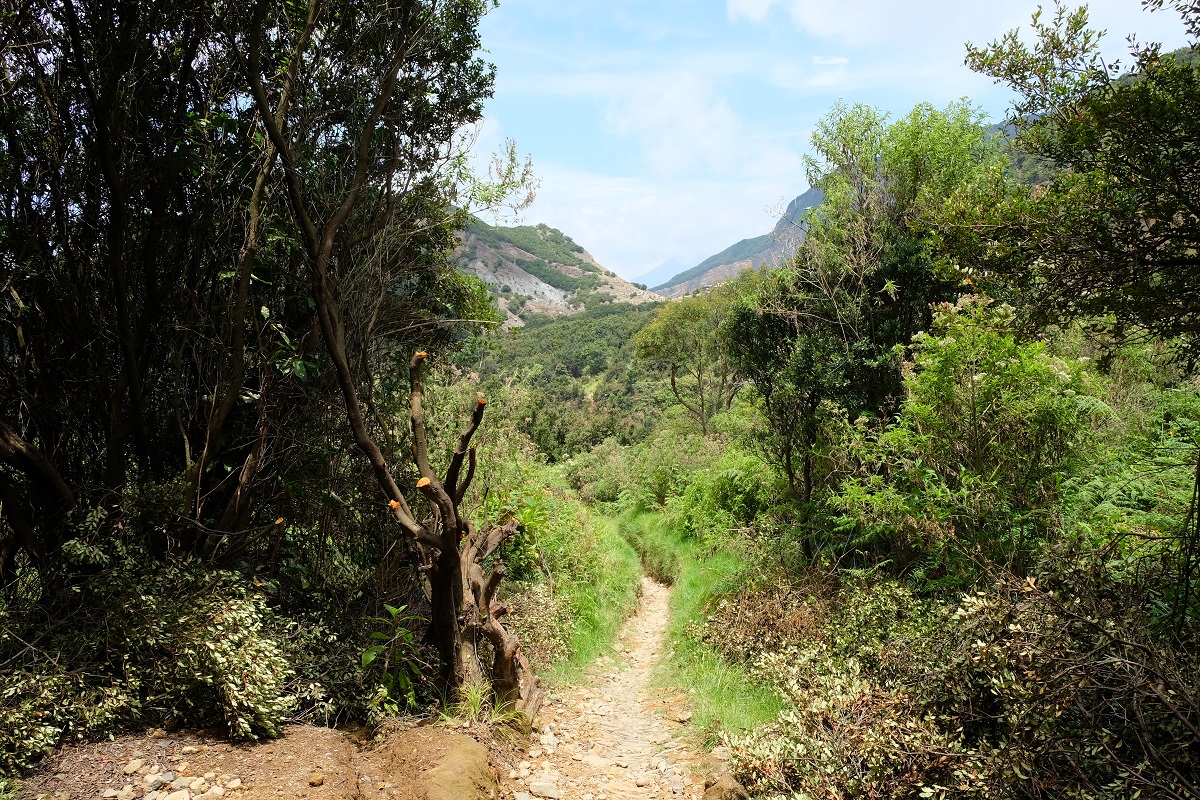
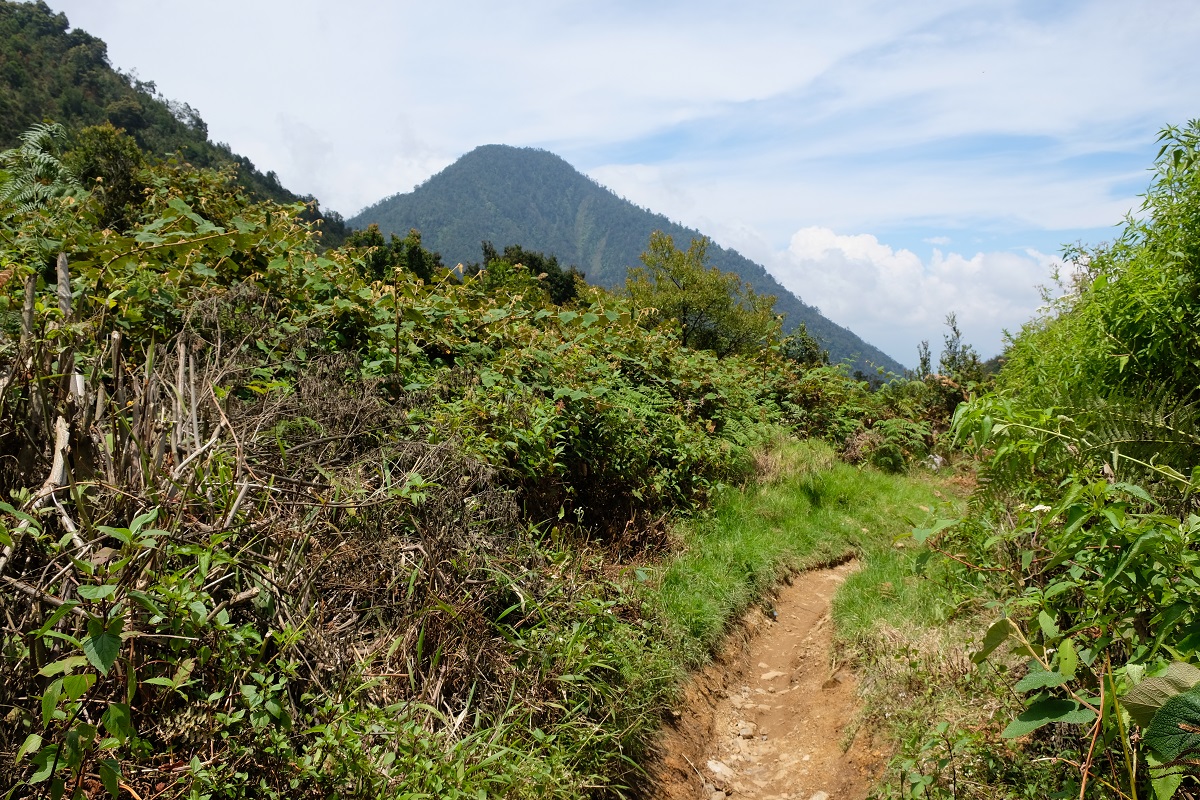

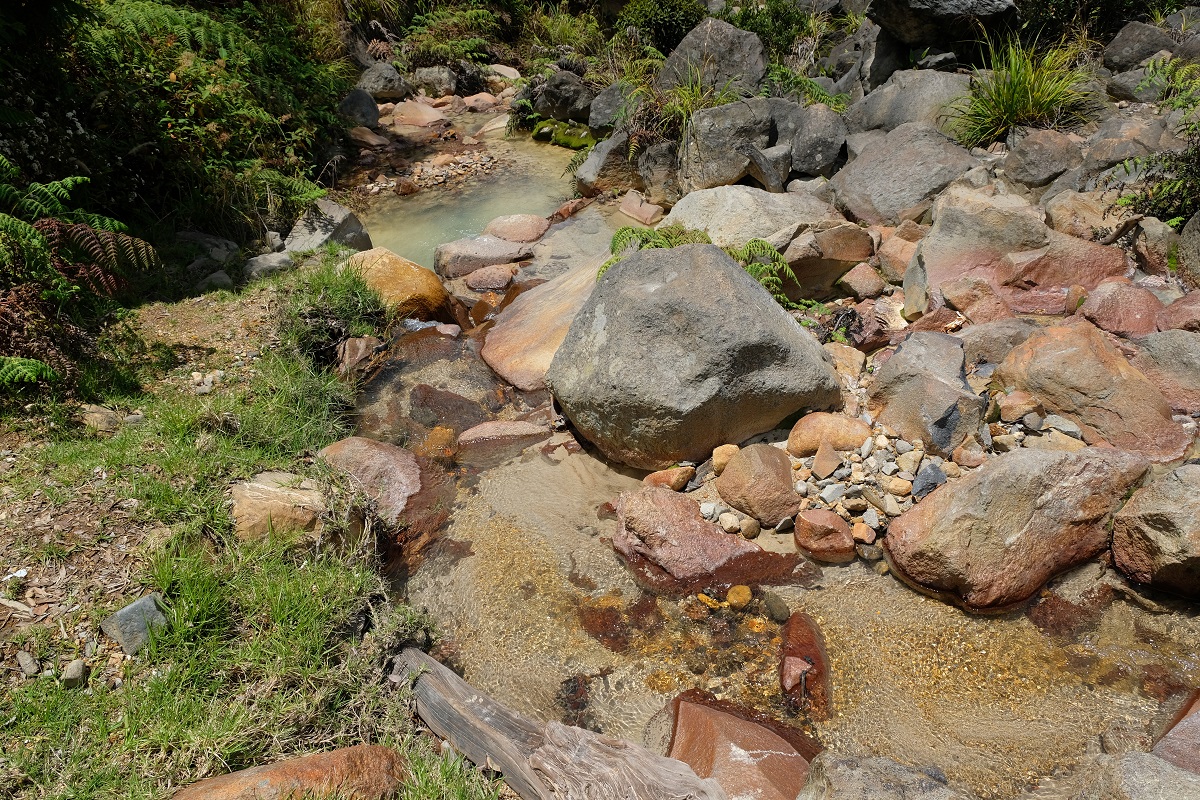

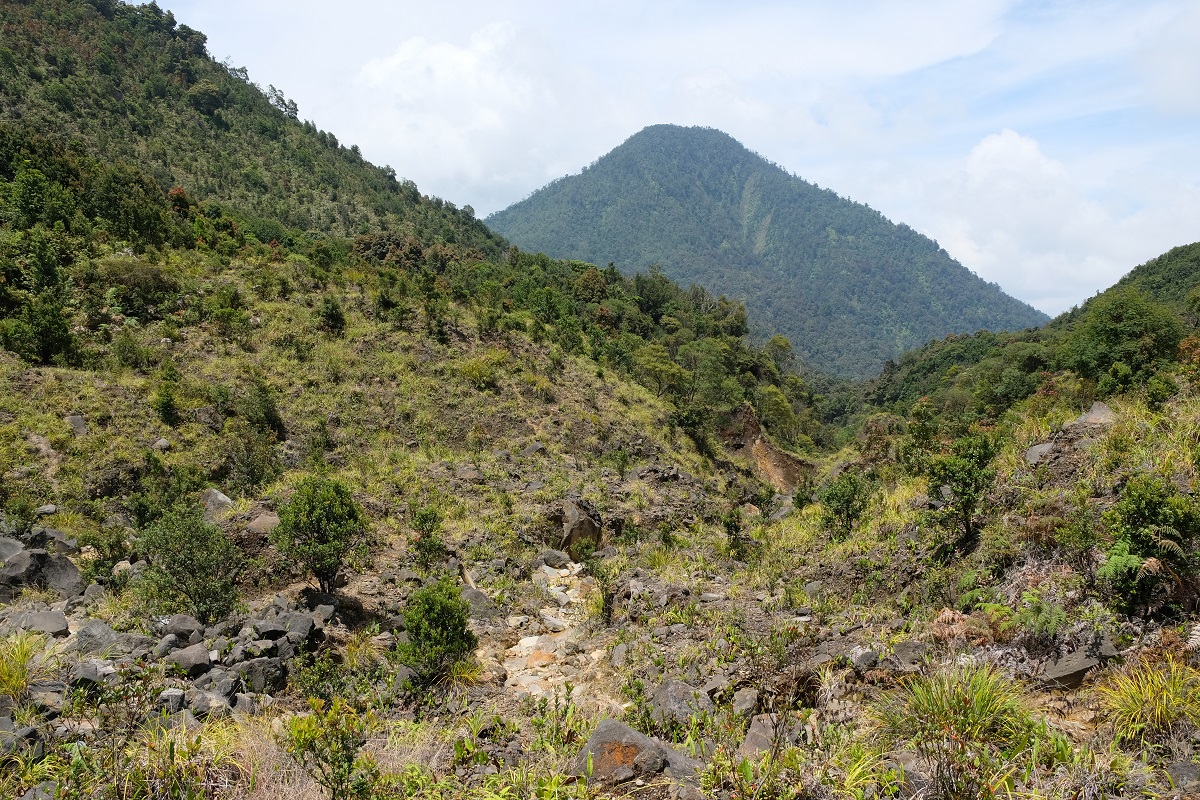

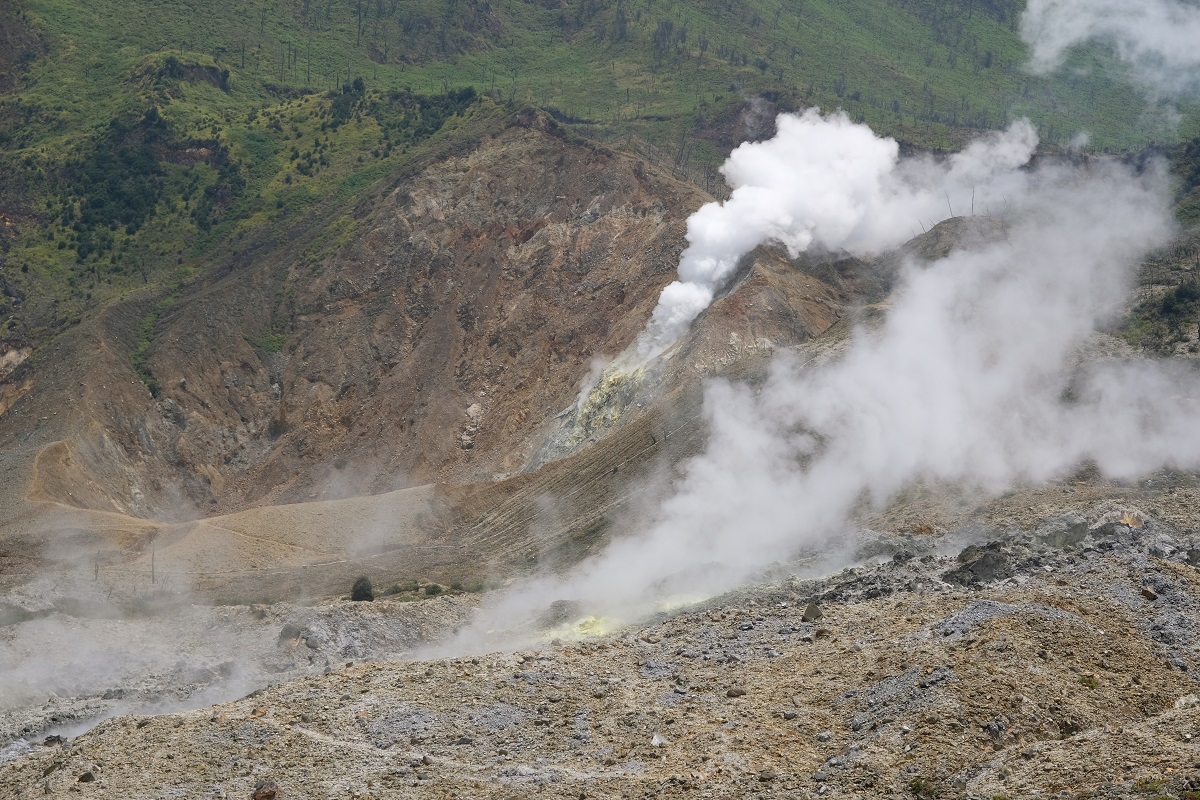
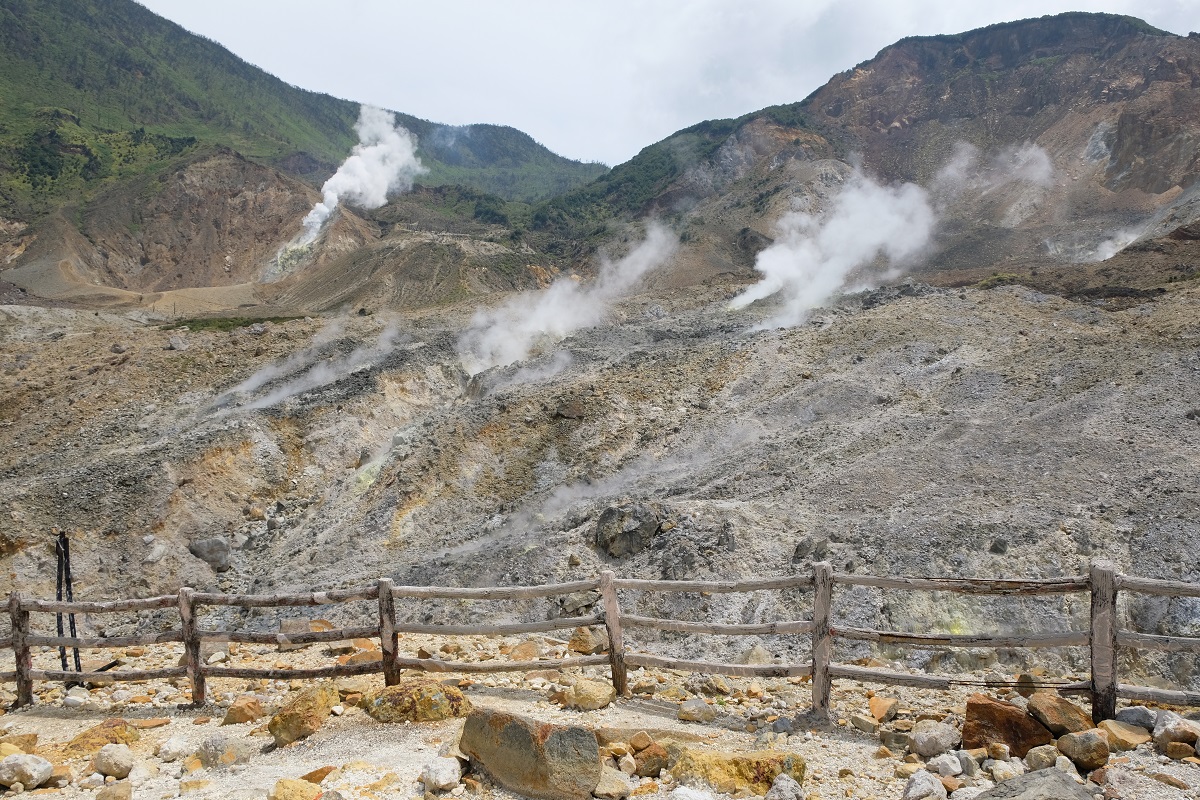
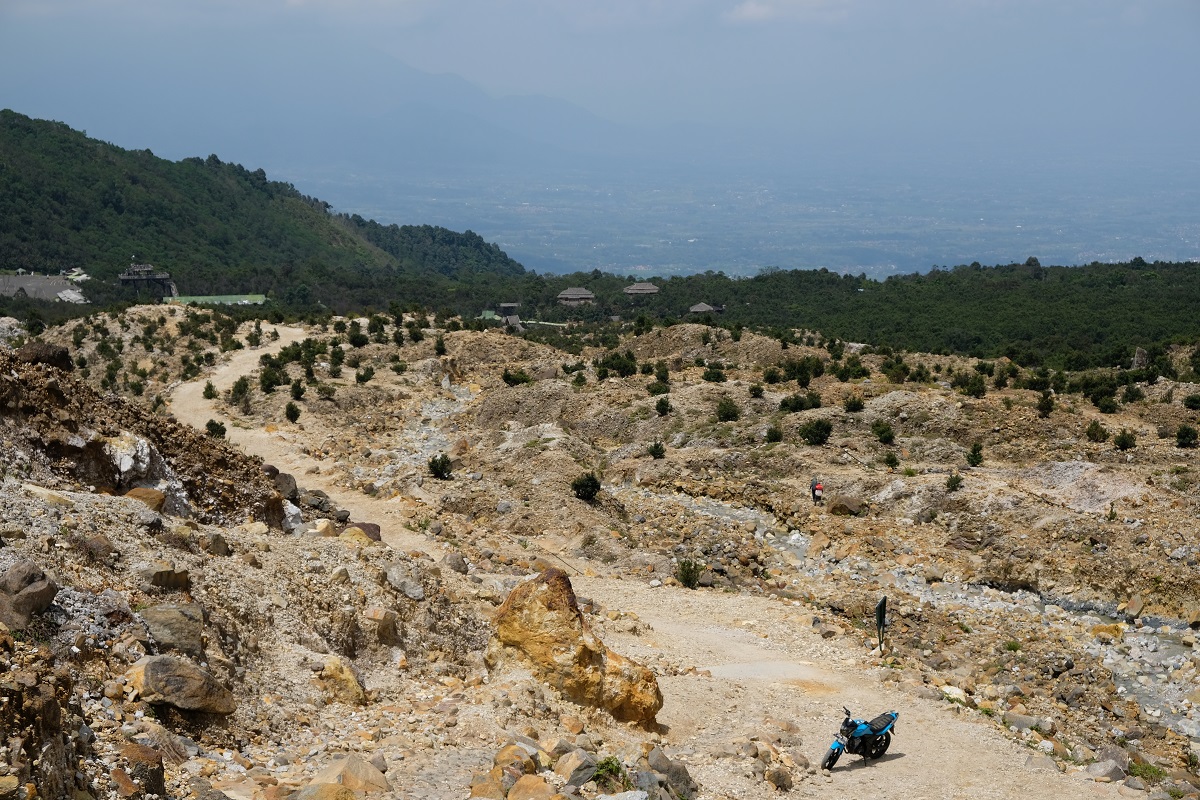
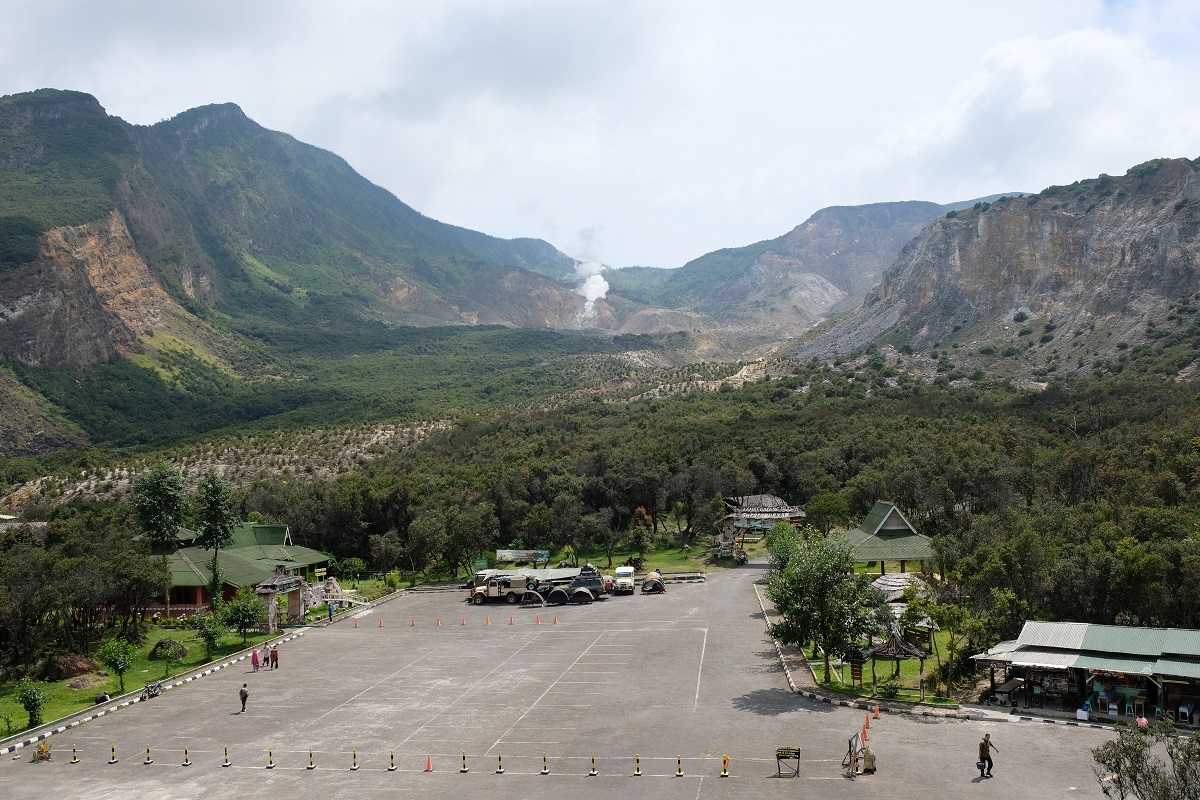


That looks like an amazing place, especially to someone like me who’s never been near a volcano. I looked up Mt. Papandayan and the topography is really complex. Probably creates interesting micro-climates. No wonder you saw such a variety of plants.
That plate of Nasi Komplit looks interesting. I couldn’t identify the green fruit next to the cucumber slices. Is it a lime or a mango, or something else altogether? Also, what is that piece between that fruit and the tofu?
LikeLiked by 1 person
That’s true. It was only when I started reading about Mount Papandayan did I realize how complex this volcano is — probably more so than some other volcanoes I’ve visited before.
That green vegetable is actually a type of eggplant widely consumed in this part of Java in its raw form. It doesn’t really have much flavor, but people enjoy its crunchy texture. As for that thing on the left of the tofu is fried tempeh (https://en.wikipedia.org/wiki/Tempeh). This soybean product has gained popularity (especially in the West) in recent years thanks to the growing number of vegetarians and vegans. But I guess it’s still very much unknown in India?
LikeLiked by 1 person
Thanks. Soyabean products are a bit of a niche specialty here. Tofu’s gaining popularity, but no one seems to be marketing tempeh. It seems to me that it will completely fit into Indian cooking (like tofu) so it’ll probably a large market when someone opens it up.
LikeLiked by 1 person
That’s what I think. I can imagine tempeh cooked with all those spices used in Indian cuisine.
LikeLiked by 1 person
Indonesia is a part of the world I hope to visit one day. Your hike looked and sounded like quite an adventure. Volcanic active places truly embody both the destruction and the rebirth in such an interesting and balanced way. The plant life you spotted were very pretty. And the lunch you had during your hike looked yum!
LikeLiked by 1 person
Hi Ab. Indonesia is halfway across the globe from where you live, so understandably going here isn’t as straightforward as visiting Europe or South America, for instance. And this is exactly the reason why I haven’t been to the Western Hemisphere. (I was supposed to go to Canada in autumn 2020, but Covid happened.) The hike to Mount Papandayan turned out more enjoyable than I anticipated. I guess this was also because of the lack of other visitors when we were there. When you do visit Indonesia one day, you shouldn’t miss its volcanoes (which we have many!) since they really play a big part in many cultures here.
LikeLiked by 1 person
Canada would be a lovely time to visit in Autumn! I hope you’ll get to have your visit one day!
And yes, volcanoes are something I hope to visit one day. I’ve travelled around the Philippines before but not at the areas with volcanos. I can see how it shapes it’s community and culture!
LikeLiked by 1 person
Interesting to think of the regrowth that happens after a volcano eruption. I often see that here in Canada after forest fires, and now forest fires are sometimes used to control overgrowth. I hadn’t thought of volcanos in the same way. Love the edelweiss, they’re very pretty and quite unique in their lighter colour. And the landscape is lovely with such lush vegetaion on the perfect cone volcanos. Maggie
LikeLiked by 1 person
The slope directly beneath a volcano’s crater is usually barren, but further down the landscape is often lush and green, and this is where a lot of people in Indonesia live despite the constant danger from the fiery mountain right in their backyard. It’s interesting that you mentioned about the forest fires in Canada. We often picture the relationship between fire and forests/plants as antagonistic, while in reality they form a healthy cycle in nature and keep everything in balance.
LikeLike
It looks like a memorable hiking. The pictures are breathtaking. It is really scary to see the gas coming out of loveable earth. Good. Keep writing.
LikeLiked by 1 person
Thank you, Pandian. In Indonesia white plumes coming out of the earth is actually quite a common sight due to the country’s high volcanic activity. Despite the danger, we accept the risk as part of our daily lives.
LikeLiked by 1 person
It sounds like quite the adventure just to get to the volcano. This looks like such an interesting hike and I love the landscape with all the dead and twisted trees. It does kind of remind me of LOTR, especially with the sulfurous gases coming out of the earth. I’m glad the clouds cleared and you were able to get some lovely views of the surrounding area. What better way to refuel after a hike than by grabbing some food. Looks delicious.
LikeLiked by 1 person
Paint Hutan Mati and its immediate surroundings (including the crater) in an even darker tone, and it would end up looking like somewhere in Mordor. What we need to watch out is, of course, not Sauron, but rather the volcano itself. We were lucky that the clouds did eventually clear so we got a good amount of sunshine throughout the rest of the hike. I wish I took a photo of our lunch with sambal on it so it would look even more enticing with a pop of red color on top of the white rice.
LikeLiked by 1 person
A superb post….and what a hike:)
LikeLiked by 1 person
Thank you, Janet. Now I’m ‘craving’ for more hike, but it’s rainy season right now in my corner of the world. So I should wait for a few more months.
LikeLiked by 1 person
Enjoy the rainy season….we need them all – Janet:)
LikeLiked by 1 person
It sounds like you’ve had a perfect kind of day, Bama. What a joy to find a plate of delicious food in an unexpected place. I just love what a difference sunshine makes to how one experiences a landscape. It really can, like magic, transform something drab and dreary into a delight for the senses.
LikeLiked by 1 person
That is so true, Jolandi. In my early years of traveling, I remember I wasn’t too bothered with the weather. But over the years, I noticed how much the sun can turn a landscape or an ancient ruin or a building into something even more beautiful. Now whenever I travel I always look up the weather forecast to better plan what to do and where to go the next day.
LikeLike
I tend to do the same. Interesting how one’s focus changes as one grows older, isn’t it?
LikeLiked by 1 person
I didn’t expect such greenery when I started reading this post! The sun’s appearance and the natural regrowth that accompanies a burn both made for a picturesque hike, and that delicious plate of food was certainly a bonus. (I swear food tastes so much better after a good hike!)
LikeLiked by 1 person
James and I had to decide whether to do the hike on Friday (less crowd, not-so-ideal weather) or Saturday (more crowd but the weather was supposed to be better). We went on Friday in the end while hoping that the sun would at least show itself when we were up there. And it did! As for our lunch, I guess the fact that we were tired but happy helped us enjoy the meal even more.
LikeLiked by 1 person
Thanks for such an informative and picturesque post! You guys have certainly had many spectacular adventures! I am sharing this with a few friends who I know will like it – some because of the vegetation, others because of the hiking.
LikeLiked by 1 person
Hi Marilyn. I hope you’re doing well. Thanks for sharing this post with your friends. I hope one day they’ll see Mount Papandayan in person.
LikeLike
I recently read an interesting (though tiny) historical comment – in 1629 a Dutch ship led by captain Francisco Pelsaert wrecked on the west coast of Australia. He and several men tried to row from there back to Indonesia and Batavia, which is now Jakarta. It did not say whether they made it. The name of the ship was also the Batavia.
LikeLiked by 1 person
Thanks for mentioning this. I just did a quick look and according to the Australian Dictionary of Biography, they did manage to reach Batavia in the end. Interestingly I can’t find any sources about him in Indonesian.
LikeLike
What a great hike – so much variety in the scenery and in the trail. If I ever get to Indonesia you have to take me on it!
Alison
LikeLiked by 1 person
Ha! It depends on how much time you have though because there are other more ‘iconic’ mountains you should see in Java.
LikeLiked by 1 person
Very nice commentary on the hike. This sounds like a volcano I would like to visit in Indonesia, although there are others like Mt Bromo and Ijen which I’m equally interested to visit once travelling is allowed again.
LikeLiked by 1 person
You mentioned two volcanoes I would recommend to anyone visiting Java for the first time. But if you do have more time, it would be nice to visit Papandayan as well.
LikeLiked by 1 person
The opening shot of Mount Papandayan with the clouds & fumes and surreal feel is a great feeling to have at the start of the hike, well done. I’d like to think living in a country with such volcanic activity gives a bit of wonder towards the power of nature and the locals a drive to visit and explore the wilderness of this activity. It is a bit like this in the Pacific Northwest of the USA (home of the great Mt. St. Helens you mention) where we have some such activity, but no where near what you have at your doorstep.
Your photos bring this feeling of stepping into a volcanic and otherworld right to me, awesome. Raw beauty, indeed. A special treat was seeing the photos of Javanese edelweiss, I’m a fan of edelweiss and have to admit the song from the Sound of Music is probably where it started 🙂 Beautiful scenic shots, isn’t this the magic of hiking? And the final treat to the post ~ the meal and happiness you find with the food stall owner and the high quality of the food. These are the little things that make an adventure something special. Great write up, Bama, a perfect retreat from the world at large. Cheers to ’22 ahead of us ~
LikeLiked by 1 person
There’s this sense of veneration toward volcanoes shared by many local communities across Indonesia, and it’s not hard to see why. I wonder if that’s also the case with the Indigenous communities along the Pacific Northwest.
It’s funny that you mentioned The Sound of Music because I was actually humming parts of Edelweiss when I was surrounded by those Javanese edelweisses! But I swear I didn’t spread my arms and dance and swirl like Julie Andrews. 🙂 I personally think a good hike must include a good dose of sunshine because it really makes a huge difference when the sun is shining.
Thanks Randall. Here’s to a better year ahead!
LikeLike
Great question, and I would bet the Indigenous communities would have a similar feeling as those across Indonesia ~ would be an interesting research project 🙂 And very funny about you also being influenced by edelweiss 🎶 such a great song and musical! Off to venture out in the sunshine today, to take advantage of such days I agree! Cheers!
LikeLiked by 1 person
Hi Bama,
Thanks for writing this! Such a nostalgic hike – Hutan Mati still gives me that strangely eerie and calming vibe. Here’s to a fulfilling year and hopefully more pretty hikes!
LikeLiked by 1 person
Hi Rey,
And thanks for reading! You describe Hutan Mati very well. If I spent longer time there, I think I would also feel calm with almost no other visitors around, only the low clouds slowly moving away from the mountain.
Hope 2022 will be great for you too!
LikeLike
Bama it strikes me that even though we live on the same planet, there are so many differences. In Canada the idea of getting used to volcanoes erupting is as foreign as a space walk. I very much enjoyed your journey, although was huffing and puffing during the hike! Amazing how nature recovers and thrives after such destruction.
LikeLiked by 1 person
On the other hand, the idea of having to endure subzero temperatures for months is just something unimaginable for many Indonesians. A lot of people here will immediately put on their sweater, sweatshirt, or anything warm as soon as the temperature ‘drops’ to low 20s Celsius — probably already considered warm in Canada. 🙂 But things like this are among the reasons why I want to see places that are so different from my home country, like your incredibly beautiful corner of the world.
LikeLike
Wow! So epic!
I’ve hiked up a live volcano in Bali. It was exhausting but I simply had to do it, although I spent most of the hike wondering why I thought it was a good idea, and bursting into tears 20 minutes after we started!
I finished the hike though – 3.5 hours later …
LikeLiked by 1 person
Oh I know that feeling, Victoria. It happened during this hike to Indonesia’s second highest volcano on the island of Lombok to the east of Bali. It was so hard I kept asking myself, why am I doing this??? I couldn’t walk properly for the whole week after that hike because all of my body was so sore. But I’m glad I did it.
It’s great that you persevered and finished the hike!
LikeLiked by 1 person
What a lovely day out in Papandayan with James. It really sounded like a wise choice to have serviced the car before going. Looks like a rather remote, quiet place. From your photos, I can definitely see why it’s called Hutan Mati. It’s not a an area buzzing with people like the city but also because of the history of eruptions in the area. The edelweiss look stunning and you captured them reall well, making them stand out amidst the greenery there. Amazing to see how there are sulferous gases coming out of the earth – like nature at work right in front of your eyes and you can actually see it.
That lady sounded so lovely and the meal looked fantastic. It sounded like they are a genuine local business eventhough in a touristy location.
Hope all is well with you, Bama 🙂
LikeLiked by 1 person
It was a nice half-day hike to Papandayan, indeed. Maybe if the weather was better, I would have enjoyed it even more. But I’m not complaining.
These days when rain falls almost every day in Jakarta, I miss going out to places like this. However, right now those trails must be really muddy!
Thank you, Mabel. Hope all is well with you too!
LikeLiked by 1 person
Mas Bama, ini Papandayan kok bersih dan sepi :’))))) Atau masih ada warung-warung nasi goreng di Pondok Saladah? Ternyata seru juga kalau naik turun langsung gak pake kemping ya, meski bayanginnya capek bener wkwk. Dulu pas ke sana kan saya camping ya. Terus malam-malam tuh ada babi nyuri mi instan dan bikin bolong tenda. Mungkin kalo kemping sekarang, yang mampir si anjing coklat itu yah xixixi.
LikeLiked by 1 person
Oh dulu pas ke Papandayan banyak sampah ya? Di Pondok Saladah cuma ada beberapa warung sih yang buka. Entah karena bukan weekend atau karena pas saya ke sana itu cuma selang beberapa minggu setelah Papandayan tutup lumayan lama gara-gara PPKM. Saya akhir-akhir ini emang lebih sering tektok sih. Terakhir camping di gunung itu kalau gak salah tahun 2013 pas ke Rinjani (ya secara Rinjani gak mungkin tektok juga kan? :D).
Ya ampun ‘seru’ banget ada babi nyuri mi instan! Hahaha. Itu kejadiannya pas pada tidur atau pas masih pada bangun? Berarti emang bener ya babi bisa nyuri makanan dari dalam tenda, soalnya selama ini sering denger cerita itu tapi belum pernah tau/kenal orang yang beneran ngalamin itu. Ya paling nggak sekarang jadi bisa bahan cerita lucu gara-gara kejadian itu ya. 🙂
LikeLike
Banyak sih gak juga, tapi gak sebersih ini. Bungkus-bungkus sama bekas minuman kemasan tuh banyak, sedih deh. Kapan-kapan cobain kemping Mas Bama, Pondok Saladah pas subuh itu cuantik buanget. Btw iya itu babinya curi mi, terus dia curinya mi goreng wakakakak. Dia lebih suka mi goreng ketimbang mi kuah, terus lebih pilih mi ketimbang sosis atau tempe padahal ada sebelahan :’))))
LikeLiked by 1 person
Sampah tuh jadi masalah klasik ya, dari dulu sampai sekarang banyak orang masih belum sadar-sadar. Hahaha, ya ampun ngakak banget soal si babi ini. Bisa-bisanya dia picky milih mi goreng, padahal gak dia masak juga, dan seleranya sosis banget ya, gak doyan tempe. 😀
LikeLike
How amazing! I think I would be a bit anxious to go on a hike near a volcano, even though I know it is not that uncommon, but what an incredible experience it must be! The “dead forest” seems very impressive and I can understand why you thought of The Lord of the Rings ahahah! I also loved seeing (and reading about) the different types of vegetation you have there as it is so different from what I know! Thank you for sharing! 😊
LikeLiked by 1 person
Volcano hikes are, as you said, quite common in some parts of the world. It’s relatively safe because most volcanoes don’t just suddenly erupt. There’s usually a period of increased volcanic activities when an eruption is imminent. However, there is indeed another risk: toxic gases. For this, you always have to heed the warnings from the local staff or those posted along the trail.
I really couldn’t get that LOTR scene out of my head when I was at the dead forest. 🙂 Thanks for reading, Juliette!
LikeLiked by 1 person
Wow! This is so amazing. I have never seen a volcano mountain in my life, let alone hike one. It sounds so adventurous. Thank you for taking us on this journey. The pictures are astounding. The forest with dead trees is a grim reminder of nature’s fury, something we can do nothing about. Again, only nature can be so giving providing with a new and fresh life even after destruction. Had never heard about Javanese edelweiss, they look beautiful. When I read your comment about it not being such an easy hike as mentioned, so many similar memories cropped up in my mind. It’s perspective in many situations while also where one starts and ends a hike. BTW, the food looks yum!
LikeLiked by 1 person
I remember you said in one of your posts that you love nature. If you happen to visit a country with volcanoes I suggest you to try climbing at least one of them. Many of these fiery mountains are actually quite benign and therefore popular among hikers. Just pay attention to local news to get the most recent updates on volcanic activities in the region, and you should be good to go. When I went to India and saw those hundreds- and thousands-year-old temples that are still standing to this day, I couldn’t help but think how Java could have looked like today if those ancient Hindu and Buddhist temples were not destroyed by volcanic eruptions and earthquakes. But again, nature has her own way.
LikeLiked by 1 person
I definitely will, given a chance. Certainly this kind of a hike I wouldn’t miss. Do hope I get the opportunity in this lifetime.
LikeLiked by 1 person
What a wonderful mix of landscapes Bama. Parts of it reminded me of the slopes of Mount Fuji for some reason! And you guys even managed a delightful meal. We are hoping to be able to immerse in nature ourselves in Sikkim next month, if things remain stable🤞
LikeLiked by 1 person
Wow, really? Now I’m intrigued to see Fuji-san! Oh I so hope your trip to Sikkim will go well, Madhu. You know how much I adore the Himalayan region. After visiting Nepal and Bhutan I wonder where to go next and I’ve been thinking of Sikkim for quite some time. Good luck!
LikeLike
Bama, this is a wonderful recap of what I felt to be the highlight of our trip to Garut. We were so lucky to have the trails on Papandayan almost entirely to ourselves – and being able to appreciate its beauty both during misty conditions and under sunny skies made the experience even more special. I do miss that kind of cool weather and the sight of the Javanese edelweiss growing on the meadows. Except for the relentlessly steep stairway up to Hutan Mati, the hike felt like a walk in the park considering our past treks on Rinjani, Prau, and Gunung Api in the Bandas!
LikeLiked by 1 person
Such is the benefit of traveling anywhere on Java not on the weekend. And due to the ongoing pandemic, having less people around is definitely a plus. Although I knew what to expect at Papandayan, I was still pleasantly surprised by what we saw during the hike, and by how good our lunch was! Despite the flies, I remember how delicious the sambal was which really elevated the entire dish. It’s been five months since that trip to Papandayan. It’s about time to plan another hike!
LikeLiked by 1 person
I think it’s always thrilling to be hiking on land that’s literally undergoing a metamorphisis under one’s feet, so close to the processes that created our home planet. Indonesia is certainly endowed with a plethoria of geologic and cultural wonders. 🙂
LikeLiked by 1 person
That is true, Henry. Going to places like Papandayan reminds us of what Mother Nature can do and where humans fit in the grand scheme of things. Indonesia certainly is an exciting place for those who want to get a closer look at how volcanoes, tectonic plates, and other natural forces have shaped this planet for eons. But for us living here in the archipelago, we have to be content (and prepared) living in close proximity with such dangerous things.
LikeLike
I loved the beginning of your post since I’ve never thought of volcanoes that way before. The destruction always paves way for regeneration and new growth. However, the loss of human life is sadly irreplaceable. The ‘dead forest’ is a hauntingly beautiful place, especially when it’s in such close proximity to lush green areas. Edelweiss is a lovely plant, the minuscule yellow flowers and the silvery colour of the leaves are such a beautiful contrast to the surrounding greenness. There are two things that serve as a perfect ending to a long hike, in my book. A nourishing plate of something delicious, and a refreshing swim. The food looks great!
LikeLiked by 1 person
Thanks Leighton. We often see destructions that are caused by Mother Nature in a one-dimensional perspective. But in reality, it’s a lot more complex than that. Volcanoes, for instance. Or natural wildfires in some parts of the world. Glad you enjoyed the hike too, albeit vicariously!
LikeLiked by 1 person
Pingback: 11 Travel Blogs Daily on My Radar You Shouldn’t Miss – A Plate for Two